I prefer small cars because they tend to be the most agile and engaging. In hatchback form, they also can be quite practical. Plus it doesn't hurt that they also tend to cost less to buy and operate. Minis might fail at "cost less to buy," but they claim to excel at "agile and engaging," with "go-kart handling" listed among the standard features on their window stickers. Sadly, previous iterations of the standard-sized Mini would not work for those of us with kids; we need rear doors. The three-door Mini Clubman, while great fun on curvy backroads, has been one door short of a complete solution. Plus its single rear door has been the rear-hinged, half-sized, "in a pinch" sort. The new-for-2015 Mini Cooper S Hardtop 4 Door, though, should be just the car we've been waiting for. But is it?
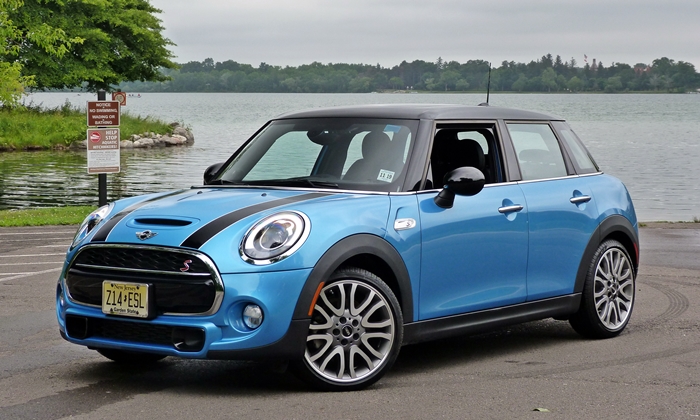
Scads of details you won't find on a GTI. The changes aren't terribly obvious from this angle. more Hardtop photos
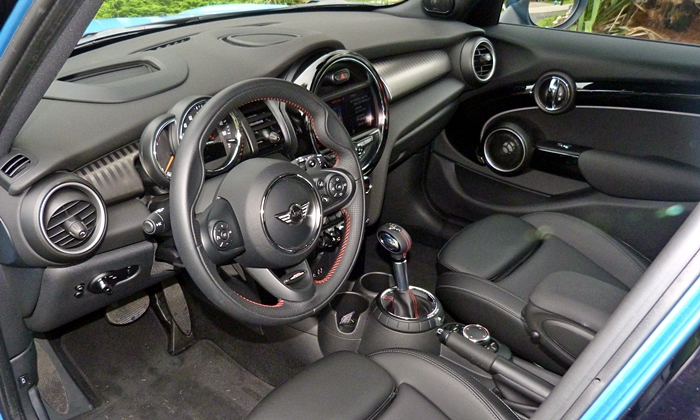
The Mini's interior is also crammed full of design. Note buried infotainment control knob.
| |
Compared to the Golf / GTI |
| Exterior styling |
|
The top reason to buy any Mini rather than something else is that Minis look special, while alternatives generally look much like the cars everyone else buys.
On top of their distinctive, retro-iconic, smaller-but-feistier-than-a-Beetle shape, Minis can be customized from the factory in a vast number of ways. As their promotional material brags, "no two Minis are alike." While two identical Minis must exist, by checking a few boxes--this body color, this roof color, these stripes, these mirrors, these wheels--you should be able to order a Mini that looks like no other on the road.
The new Hardtop's interior similarly has distinctive styling that can be thoroughly customized in terms of color and trim. I especially liked the patterned aluminum trim in the tested car.
Unfortunately, the basic Mini has grown once again, this time to such an extent that it has become a cliche to question whether it remains mini. The first Mini developed under BMW ownership and influence, the 2002-2006 R50/R53 Hardtop, was 143.1 inches long. The second, the 2007-2013 R56 Hardtop, was 145.6 inches long. The 2014 and up Hardtop is 151.1 inches long in 2-door "F56" form and 157.4 inches long in 4-door "F55" form.
Aesthetically, the big issue isn't the increase in itself, but (as tends to be the case) where it is situated. While the new Hardtop 2 Door is eight inches longer than the R50, its wheelbase is only an inch longer--nearly all of the increase has been in the overhangs, where the eye least wants to see it. Compared to the 2 Door, the 4 Door has three inches more wheelbase, but six inches more length--the other three further extending an already extended rear overhang.
Unusually tight proportions--i.e. short overhangs--have been key to the attractiveness of past Minis. But the third-generation Hardtop's proportions aren't nearly as athletic. The extended nose, allegedly forced by European pedestrian safety regulations, appears especially unattractive. Attempts to trick the eye--sloping the leading section of the hood, laying back the round (make that oval) headlamps--only serve to make the car's face appear aquatic. Volkswagen must wrestle with the same regulations, yet the latest Golf, while also larger than its predecessors, is more attractive than its predecessors.
So why might more than a few people prefer the exterior of the Mini, distended schnozz and all? The sheetmetal of the GTI might be the most artful to date, but it's still the sheetmetal of a Golf, one of the best-selling cars in the world. Plus if you've seen one new GTI, you've pretty much seen them all. Appearance options are limited to six exterior colors (only one of them colorful) and either plaid cloth or black leather seats.
Note: I haven't rated these cars against each other on styling because of an apples-vs.-oranges issue. Do you want subtly attractive or "look at me" distinctive?
| Materials & workmanship |
 Better
Worse
Better
Worse
|
The interiors of past Minis included parts here and there that seemed unworthy of the cars' semi-premium pricing. The redesigned interior, though it still includes more hard plastic than you'll find in a BMW, looks and feels higher in quality than those of past Minis. A GTI is about as nice (if much less distinctive) inside, but other compact hathbacks seem like the less expensive cars they are.
Beyond the interior, the Mini's doors shut with an especially satisfying, unusually mechanical ker-chunk. I wish my Mazda's doors sounded or felt half as solid when closed.
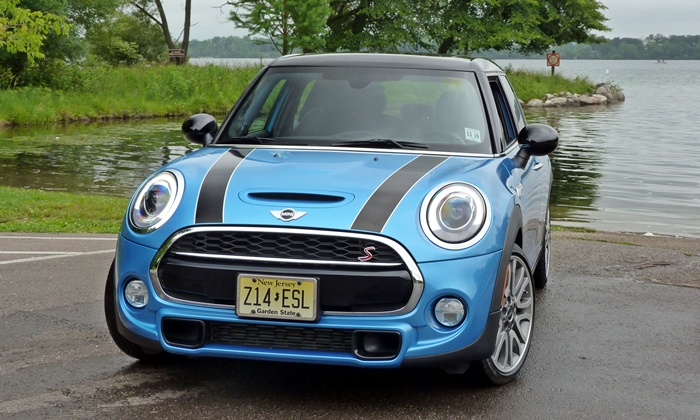
Laid back headlamps, large protruding grille look fishy. Hood scoop still indicates this is an S.
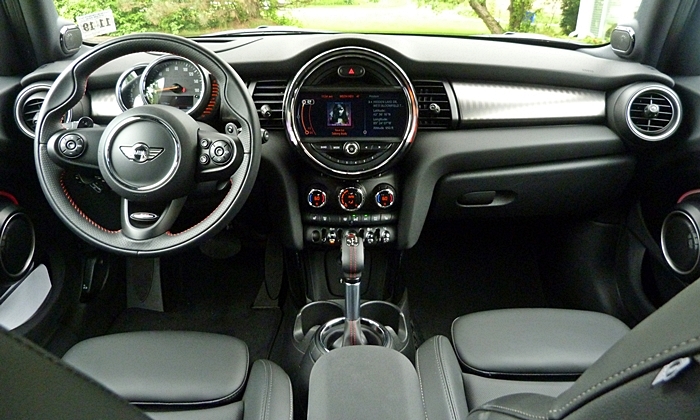
Improved ergonomics, but work remains to be done.
| Fuel economy |
 Better
Worse
Better
Worse
|
Compared to most other performance-oriented cars, the 189-horsepower Mini Cooper S Hardtop is more fuel-efficient. With a six-speed manual transmission, the car achieves 24 mpg in the EPA's city test and 34 mpg in the highway test. The tested car's automatic transmission shaves an mpg off the highway figure but adds two in the city (26/33). In my suburban drivingn the trip computer typically reported low 30s, but as high as 38 with a relaxed right foot in "Green Mode."
All pretty good, but the Mini's closest competitors are about equally economical. The much larger (but somehow not much heavier) Volkswagen GTI's EPA ratings are 25/33 with two pedals and 25/34 with three. The Ford Fiesta ST slightly tops them both with 26/35, but isn't available with an automatic transmission.
Don't need 189 horsepower? The 134-horsepower non-S Cooper Hardtop achieves 29/40 with the manual transmission and 28/37 with the automatic. To match these figures (and then some) the Golf needs a diesel. The Fiesta, on the other hand, is available with a 1.0-liter turbocharged three-cylinder engine good for 31/43--but this engine is only offered with a manual transmission.
| |
Compared to the Golf / GTI |
| Price or payments |
 Better
Worse
Better
Worse
|
Compared to other small hatcbacks (most or which remain larger than the enlarged Hardtop), the Mini costs considerably more. The Cooper Hardtop 2 Door starts at $21,550. Add $3,400 for a fourth cylinder and $1,000 for a second set of doors to arrive at the base price of the new Cooper S Hardtop 4 Door, $25,950.
But who gets a base Mini? There are so many enticing options to choose from. Unlike elsewhere, most features can be ordered a la carte, not only as part of a package. Check all the boxes, and the sticker will top $40,000. The tested car, with black leatherette seats, listed for $35,900.
A Ford Fiesta ST, similar in performance, size, and interior space to the Mini, but with a friskier personality, lists for about $5,500 less, only about $1,000 of which can be accounted for in the Mini's additional content.
A Volkswagen GTI, with more power and much more interior space, has a similar base price, but lists for about $2,500 less when both are equipped with paddle-shifted transmissions, heated leather seats, sunroof, nav, and 400-watt audio systems. On top of this, the optioned-up GTI has about $1,000 in additional content. Fully load both cars, and the gap widens further. Mini offers more options, but also tends to charge significantly more for them.
| Driving position & visibility |
 Better
Worse
Better
Worse
|
I've never cared for the driving position in BMW-era Minis. Their upright windshields are positioned so far forward that I feel like I'm driving a box. This also visually distances the driver from the road, the opposite of what I usually like about small cars. In the new Hardtop the instrument panel seems taller and more massive than before, turning the box into a bunker. Raising the driver seat an inch or so helps some, but not nearly enough to keep this driving position from being my least favorite aspect of the new Hardtop.
In comparsion, the driving position in the new GTI, with its thinner A-pillars and much larger, more conventionally located windows, is outstanding. That of the Ford Fiesta ST, with an excessively deep instrument panel, falls between the other two.
On the positive side of the ledger, tall drivers report that they fit surprisingly well in the Mini. One fairly tall member has both a Mini and a GTI, and prefers the amount of space inside the Mini.
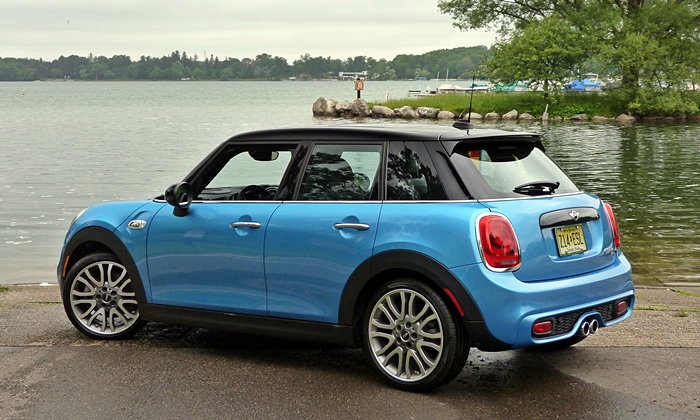
The new Mini looks best from the rear quarter (because you can't see its face).
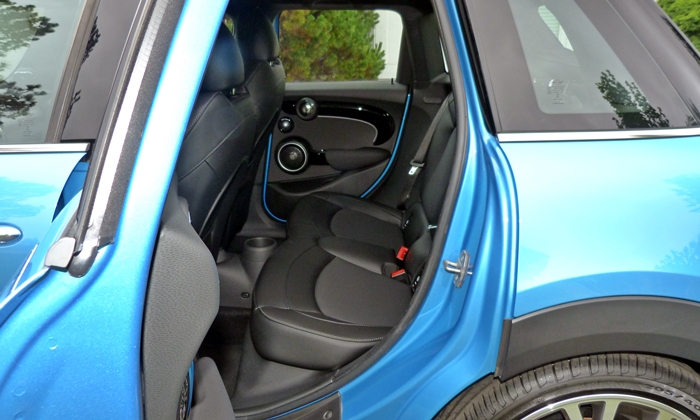
More rear legroom than in previous Hardtops, but still a squeeze.
| Controls and instruments |
 Better
Worse
Better
Worse
|
The instruments and controls in modern Minis have been...idiosyncratic. One notable idiosyncracy has been deleted with the latest redesign: the plate-sized centrally located speedometer, which was far too large and far too close to actually be used as a speedometer, instead serving as retro decor. The infotainment display, which used to replace the speedometer on Minis with navigation, now owns that space even in cars without nav.
Another notable change: the small joystick formerly used for selecting infotainment settings has been replaced with a large knob. This knob, much like that in recent BMWs, has a touch-sensitive top surface with handwriting recognition. While the knob is easier to operate and feels sturdier than the fiddly joystick, like the joystick it is mounted low between the seats. Lowering the armrest makes it especially difficult to reach and operate. In BMWs the knob is mounted farther forward and just a little lower than the armrest, a much more ergonomic location.
One new element: the ring around the infotainment display now lights up, and in different colors depending on the mode (Red for sport, Green for eco) and what you are doing with the controls (briefly blue when you turn the interior temperature setting down, briefly red when you turn it up, etc.). A fun light show.
Another new feature: a head-up display (HUD) is a $500 option. The HUD can only display vehicle speed and basic nav information (no tach, which would be more useful, at least for me), adds an unsightly lump to the top of the instrument panel, and impinges upon the already restricted view forward. I had to consult the owner's manual (built into the infotainment system) to figure out how to raise the HUD's screen--a toggle switch all the way to the right at the bottom of the center stack. The conventional location, to the left of the steering wheel, would be much closer to the HUD, and so more logical. I soon put the screen back into its hidey-hole. Save your $500.
The controls in the Ford Fiesta ST have their own issues. In cars with MyFord Touch, the touchscreen is too small and too far away for easy use.
The GTI's controls are easier to operate. A touchscreen and its associated buttons are all mounted high on the center stack. Nothing is buried down between the seats. To be fair, this relative ease-of-use is partly because you can't do as much with the VW's controls, as its infotainment system is simpler / less feature-rich. The VW gains a more advanced infortainment system for 2016, the usability of which remains to be seen.
| Ride smoothness |
 Better
Worse
Better
Worse
|
The new Mini Hardtop, especially the 4 Door with its stretched wheelbase, rides significantly more smoothly than its predecessors. But the ride still can become choppy, especially on the highway. The standard run-flat tires, plus-one'd to 205/40WR18 Pirelli P7s on the tested car, could deserve some, perhaps even most of the blame. Optional adaptive dampers could improve both ride quality and handling. (They weren't on the car tested.)
The GTI rides more smoothly and quietly even without its optional adaptive dampers.
I cannot comment on the Fiesta ST's ride quality, as my driving was largely limited to smooth roads.
| Rear seat room & comfort |
 Better
Worse
Better
Worse
|
The 4 Door has 1.5 inches more rear legroom than the regular Hardtop, but 32.3 inches still isn't much. At 5-9, I can squeeze behind myself with perhaps an inch between my knees and the carved-out front seatbacks. Rear headroom is relatively abundant even though the seat cushion is mounted a comfortable height off the floor. The rear doors, though an improvement over the Clubman's single rear-hinged half-door, are still small and don't open wide.
A Ford Fiesta ST might be at least as tight in the back seat, but the GTI, with 35.6 inches of rear legroom, is far roomier and easier to get into and out of.
| |
Compared to the Golf / GTI |
| Cargo capacity |
 Better
Worse
Better
Worse
|
The enlarged body, with its additional rear overhang, benefits cargo volume more than it does rear seat room. The 2007-2013 Mini Hardtop could only hold 5.7 cubic feet with the rear seat up and 24.0 with it folded. The current Hardtop 2 Door can hold 8.7 and 34.0 cubic feet, respectively, about even with the Clubman. And the new Hardtop 4 Door? 13.1 cubic feet with the rear seat up and 40.7 with it folded, a big jump over the previous generation Hardtop, usefully more than the Clubman, and about even with the longer, wider, and taller Countryman crossover.
The Ford Fiesta ST, though a couple inches longer than the Hardtop 4 Door and equally wide, has a much rounder tail and its back seat doesn't fold nearly as flat. Perhaps for these reasons its maximum cargo volume is a much less impressive 25.4 cubic feet. Then again, the Ford's "seat up" spec is a more competitive 14.9 cubic feet.
The GTI, with ten inches more length to work with, can carry considerably more than the Mini: 22.8 cubic feet with the seat up and 52.7 with it folded.
| Front seat support & comfort |
 Better
Worse
Better
Worse
|
The sport front bucket seats standard in the Cooper S Hardtop, though firm, proved comfortable. Large bolsters provide plenty of lateral support in hard turns. Drivers with long legs will appreciate the manually adjustable thigh support. Tall drivers take note: Mini claims those up to 6-7 will fit comfortably in the driver seats of its cars.
The GTI's front seats provide a similar level of lateral support, but aren't contoured quite as comfortably and lack an adjustable thigh support.
The Fiesta ST's optional Recaro buckets are the most aggressively bolstered, but all but slender drivers tend to find them overly tight.
| Powertrain performance |
 Better
Worse
Better
Worse
|
First, a quick note on the 134-horsepower 1.5-liter turbocharged three-cylinder engine in the non-S Cooper Hardtop. Though large for a triple, it doesn't feel rough and growls at least as pleasantly as the Cooper S's four-cylinder. But it has a narrower range and delivers well beyond adequate but short of thrilling performance--figure low 8s from a dead stop to 60 mph. It's best bought by those who won't often be visiting the red line, and especially by those who place a higher priority on fuel economy than juvenile pleasures.
The Cooper S Hardtop, with a fourth 500cc cylinder and 189 horsepower, is of course quicker than the non-S Cooper, yet still doesn't feel terribly quick. Figure high sixes to 60. The combination of this engine and the six-speed automatic transmission in the default "Mid Mode" can even feel laggy and sluggish at around-town speeds. "Sport Mode" dramatically quickens the powertrain's responses, but also holds a lower gear unless you work the optional paddle shifters, to the detriment of fuel economy. The VW's and the Ford's turbochargers deliver their boost more seamlessly, and the VW engine, though no larger, feels stronger (though it is only a few tenths quicker according to magazine tests).
Then again, both the VW and Ford benefitted in my testing from the more direct, more involving connection provided by a manual transmission (mandatory with the latter). When I earlier drove the GTI with the optional DSG transmission, and this transmission actually makes the car a little quicker (as does the automatic in the Mini), I enjoyed it less. I've also briefly driven the new Mini Hardtop with a manual transmission and, like the VW, enjoyed it more with a third pedal, if still not as much as the GTI.
Shifting from qualitative to quantitative concerns, if you want to at least match (and likely beat) the 220-horsepower GTI's acceleration you'll have to spend another $6,500 for the 228-horsepower John Cooper Works Hardtop--which inexplicably isn't offered in four-door form, at least not yet.
Since at least the second generation Mini's traction control systems have effectively compensated for the shortcomings inherent in channeling considerable horsepower entirely through the front wheels. You'll spin the inside front tire much more easily in some other front-wheel-drive cars. But the Ford and VW also perform well in this regard. Plus you can get a mechanical limited-slip differential in the GTI.
| Handling |
 Better
Worse
Better
Worse
|
Mini lists "go-kart handling" as a standard feature. I did not experience it.
Not that the new Hardtop doesn't handle well in a technical sense. Its chassis feels more solid, stable, and composed than those of the previous generations. On a challenging road or track it performs very well, with precise responses, minimal lean, substantial grip, and no unpleasant surprises.
My issue with the car's handling is subjective: even with the addition of brake-based torque vectoring the enlarged Hardtop just doesn't feel agile. Instead, the hatch feels larger and heavier than it is, even bulky, especially in relatively casual driving. Heavy, somewhat dull steering, which becomes even heavier but no sharper in "Sport Mode," is one part of the problem. The aforementioned driving position, dominated by a tall instrument panel and distant upright windshield, is another. Overall Mini seems to have tuned the car to feel solid and "serious," much like recent BMWs I haven't much enjoyed, rather than nimble and playful. Has the culture of corporate parent BMW seeped in too deeply, displacing whatever used to make Minis feel like Minis?
Despite its larger size, the GTI feels more lively, in part because its torque vectoring system noticeably enhances the car's willingness to turn. Unlike with the Mini, the more I drove the GTI the more I enjoyed it, despite a more subtle personality than that of its archrival, the brash Ford Focus ST. (For the details, check out that comparison.)
The Ford Fiesta ST feels the most agile, but not to the extent I expected given dimensions similar to the Mini's and the lowest curb weight in the threesome (2,742 vs. 2,895 vs. 3,031 lbs.). Like the Mini, if to a lesser extent and with more satisfying results, it needs a challenging road to really make it come alive. I haven't yet experienced the Fiesta ST in typical daily driving (only on somewhat curvy country roads and a track, where it leaned more than the Mini), but my sense is that the GTI is at least as enjoyable when simply driving around town.
With a foot less length than the GTI and two inches less height than the Fiesta ST, the Mini Hardtop 4 Door should feel more agile than either. Hopefully there's something Mini can do to better realize the car's handling potential. Unfortunately, they can't enlarge and reposition the windshield without a complete redesign, which could be a decade off.
| Reliability & durability |
 Better
Worse
Better
Worse
|
The Mini Hardtop, the VW GTI, and the Ford Fiesta all have been the subject of more than their fair share of owner horror stories. At this point, all three models are too new to know how they'll hold up in the long run. As I write this, though, the 2015 GTI is better than average, the 2014-2015 Hardtop is about average, and the 2014 Fiesta is somewhat worse than average (we don't have enough participants for the 2015).
I should have loved the new Mini Cooper S Hardtop 4 Door. Instead I liked it a little less each time I drove it. What happened?
With the latest Hardtop, Mini / BMW seems to have lost sight of what has made past Minis so enjoyable to look at and drive. The new car's proportions, with far more overhang, aren't nearly as attractive. Worse, the new car drives like it looks. It feels bloated rather than lithe and agile. The small distant windshield doesn't help. While the new car's more substantial feel can also be a benefit, and it does ride more smoothly, more has been lost than has been gained.
But those seeking the feel of a larger car can always buy a larger car. Mini itself has a much-enlarged Clubman (with four conventional doors) on the way, and no doubt an even larger Countryman after that. Beyond the Mini range, BMW also offers its own cars up to a long-wheelbase 7 Series and gargantuan Rolls Royces beyond that. Every car within the BMW family does not have to drive like a vault-on-wheels.
Small, agile, quick cars, especially those with four doors, are in far more limited supply, so I was hopeful that the new Hardtop 4 door would deliver both the utility I need with the driving experience I desire. Unfortunately, it realizes the potential of its still compact (if less so) dimensions considerably less than the Ford Fiesta ST does. Even the much larger Volkswagen GTI feels more agile, while offering much more room for passengers and cargo.
Why, then, would anyone buy the new Hardtop? Most likely because it continues to look different and more special than other small hatchbacks. Plus, by checking the right boxes, yours can even look different than any other Mini. In a world awash with red GTIs (that largely resemble the pedestrian Golf), this counts for something.
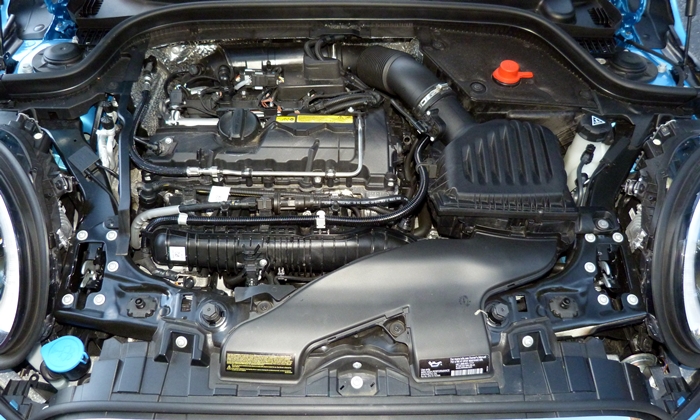
New engine delivers good but not outstanding performance and fuel economy.
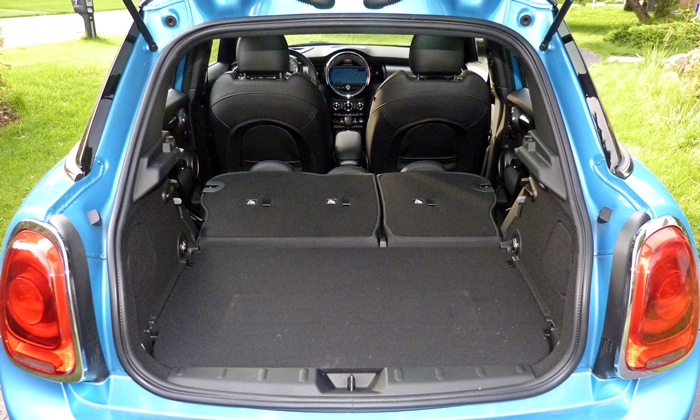
4 door can hold much more than 2 door. Floor can be raised to make it level with the folded seats.
See more 2015 Mini Hardtop photos
Mini and Volkswagen each provided a car for a week with a tank of fuel. Mini also provided cars at a regional media event, while VW also provided them at an event for invited media. Food and lodging was comped at both events.











